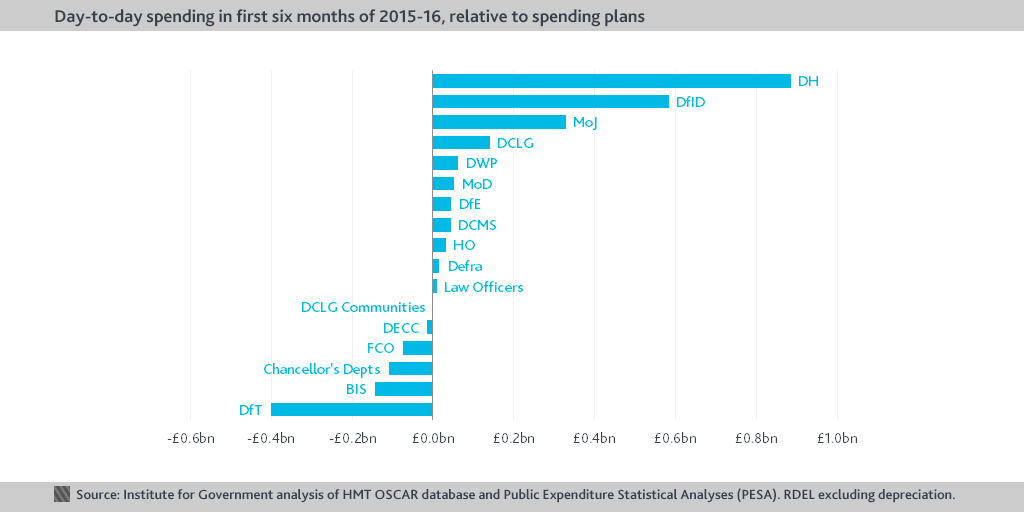The public finance numbers for December are due to be published tomorrow, showing the latest top-level figures for tax receipts, spending and the deficit. Julian McCrae looks at what we know about how spending has fared so far in 2015/16, and what this means for the fiscal plans.
The last public finance figures, published just before Christmas, show that overall government spending for the first eight months of 2015/16 is running 2% ahead of spending in the previous year. This compares to government plans for spending to rise by 1% for the year as a whole.
Since these figures were published, we’ve had a chance to look at the more detailed departmental spending figures that the Government publishes quarterly. These figures provide a lot more detail on what’s happening in key areas, though they are not quite as up-to-date as the overall numbers (which cover the first six months of 2015/16). The departmental figures give us a better sense of the sustained pressures on the Government’s budget, as it is possible to strip out accounting and other adjustments that can have a big effect on the top-level numbers.
The chart shows how day-to-day departmental spending (for those who know their public finance aggregates, resource DEL – departmental expenditure limits – excluding depreciation) in the first six months of 2015/16 compared to what might have been expected, given each department’s spending plans for the year as a whole. (The expectation is the spending in the first six months of 2014/15, increased or decreased at the planned annual rate.)
Some headline points are:
1. The Department of Health (DH) is, unsurprisingly, overspending compared to plans. As many, including The King’s Fund, have pointed out, the NHS is now the recipient of a series of cash injections to keep it going. The figures for the first six months show DH’s day-to-day spending rising by 3.9% compared to the first six months of 2014/15, despite the fact that the planned increase for the year as a whole is 2.3%. The gap between plans and actual spending (£865m) is greater than at the same stage in 2014/15 (when it was only £200m).
2. There is a big difference between the Department for International Development (DFID)’s spending so far and the Government’s plans. DfID is primarily a grant giver, rather than an organisation that runs ongoing services like hospitals and schools, which means that its spending may vary quite a bit over the year. It saw a 21% increase in spending this year compared to the same period last year. This is in the context of a small – 1.4% – planned increase for the year as a whole. DfID’s overspend in the first six months of 2014/15 reversed itself rapidly in the second half of the year, and we may well see the same pattern again this year.
3. The Ministry of Justice (MoJ) is worryingly far off target. MoJ has seen a 3.1% fall in its day-to-day spending compared to 2014/15, which sounds rather good (at least from a fiscal hawk’s point of view). However, the department needs to cut its spending by over 12% this year to meet the Government’s plans. So it looks as though MoJ has a lot of catching up to do in the second half of the year. And that is unlikely to be the end of the story – this is a department with one of the toughest settlements in the recent spending review.
4. The biggest departments’ day-to-day spending is ahead of plans. Aside from DH, spending at the Department for Education is running £45m ahead of its planned 1.9% increase, while MoD is spending £50m ahead of its planned 5.9% increase. These are relatively small differences, and the situation for MoD is better than it was at the same point last year.
5. Some departments have spent less in the first six months than would have been expected. The most important of these is at the Department for Transport, where spending is around £400m less than planned. This is mainly accounted for by a sharp reduction in the Transport for London grant, suggesting that we’re seeing a timing effect.
Overall, departments’ day-to-day spending is almost £2bn ahead of what would be expected given the Government’s plans, compared to being £1bn below plans at the same point in 2014/15. These are small amounts in the context of government spending, and a lot of it may be down to timing. For instance, the Office for Budget Responsibility (OBR), is talking about cuts that were announced in June kicking in before the end of the financial year (though there are reasons to be sceptical about how sustainable some of these cuts really are).
The Government will probably be pleased that, problems in the NHS aside, it is still broadly on track to meet its spending plans. But the data also suggests that things are getting more difficult, a trend that is likely to continue over the next four years.
Abbreviations for government departments can be found here.
- Topic
- Brexit
